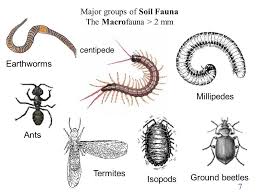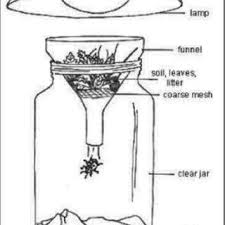Macrofauna: Difference between revisions
No edit summary |
|||
| (6 intermediate revisions by the same user not shown) | |||
| Line 1: | Line 1: | ||
==Overview== | ==Overview== | ||
Macrofauna are the [[animals]] in the [[soil]] that can be seen by the naked eye. Macrofauna range from sizes of around 2mm to 20mm. These species easily move around in the soil and change the structure of the soil. Common species would be earthworms, myriapods, spiders and more. Macrofauna are important in the process of mixing soil and creating spaces within the soil. [[File:Soil_macrofauna2.jpg|thumb|border|right| | Macrofauna are the [[animals]] in the [[soil]] that can be seen by the naked eye. Macrofauna range from sizes of around 2mm to 20mm. These species easily move around in the soil and change the structure of the soil. Common species would be earthworms, myriapods, spiders and more. Macrofauna are important in the process of mixing soil and creating spaces within the soil. [[File:Soil_macrofauna2.jpg|thumb|border|right|<ref> Hutapea, Sumihar, and Indah Apriliya. Biological Soil Properties. http://indahapriliya.blog.uma.ac.id/wp-content/uploads/sites/620/2020/11/6th-Meeting.pdf</ref>|Common soil macrofauna]] | ||
Macrofauna can have many roles in the soil such as soil engineers; who shape and structure the soil, shredders; who breakup [[Organic Matter|organic matter]] and predators. Macrofauna can also be used to determine soil quality due to their direct involvement in the soil.<ref>Moreira, F.M.S., Huising, E.J., & Bignell, D.E. (2008). A Handbook of Tropical Soil Biology: Sampling and Characterization of Below-ground Biodiversity (1st ed.). Routledge. https://doi.org/10.4324/9781849770286</ref> | Macrofauna can have many roles in the soil such as soil engineers; who shape and structure the soil, shredders; who breakup [[Organic Matter|organic matter]] and predators. Macrofauna can also be used to determine soil quality due to their direct involvement in the soil.<ref>Moreira, F.M.S., Huising, E.J., & Bignell, D.E. (2008). A Handbook of Tropical Soil Biology: Sampling and Characterization of Below-ground Biodiversity (1st ed.). Routledge. https://doi.org/10.4324/9781849770286</ref> | ||
==Sampling methods== | ==Sampling methods== | ||
Samples are taken by using the [[Berlese tullgren funnel]] method, a method that forces fauna down a tunnel into a collection vessel due to their negative reaction to light. [[File:tullgren funnel.jpg|thumb|border|right| | Samples are taken by using the [[Berlese tullgren funnel]] method, a method that forces fauna down a tunnel into a collection vessel due to their negative reaction to light. [[File:tullgren funnel.jpg|thumb|border|right|<ref> “Invertebrate Capture Techniques - Chapter 6.” Consult-Eco, https://stevemcwilliam.co.uk/entomol/invcapt6.htm. Accessed 30 April 2025.</ref>]] | ||
Soil and soil litter are held up by a coarse mesh that allows the fauna to crawl through.<ref>Hennen, Derek. “Building a Homemade Berlese-Tullgren Funnel — Derek Hennen.” Derek Hennen, 2 October 2021, https://www.derekhennen.com/blog/2021/10/2/berlese-funnel. Accessed 30 April 2025.</ref> Because of the nature of most [[arthropods]], the heat lamp at the top drives the animals down the funnel and into the collection container. This separates the fauna from the soil making it easy for population counts and individual species examination. | Soil and soil litter are held up by a coarse mesh that allows the fauna to crawl through.<ref>Hennen, Derek. “Building a Homemade Berlese-Tullgren Funnel — Derek Hennen.” Derek Hennen, 2 October 2021, https://www.derekhennen.com/blog/2021/10/2/berlese-funnel. Accessed 30 April 2025.</ref> Because of the nature of most [[arthropods]], the heat lamp at the top drives the animals down the funnel and into the collection container. This separates the fauna from the soil making it easy for population counts and individual species examination. | ||
==Common Macrofauna== | ==Common Macrofauna== | ||
* | *[[Earthworm]] | ||
* | *[[Pot Worms]] | ||
*springtails or [[collembola]] | *springtails or [[collembola]] | ||
*[[mites]] | *[[mites]] | ||
| Line 22: | Line 23: | ||
Earthworms make up about 80% of macrofaunal abundance, alongside springtails, potworms and mites that are also extremely common. <ref>Briggs, R. (2004). SOIL DEVELOPMENT AND [[Properties|PROPERTIES]] | The Forest floor. In Elsevier eBooks (pp. 1223–1227). </ref> | Earthworms make up about 80% of macrofaunal abundance, alongside springtails, potworms and mites that are also extremely common. <ref>Briggs, R. (2004). SOIL DEVELOPMENT AND [[Properties|PROPERTIES]] | The Forest floor. In Elsevier eBooks (pp. 1223–1227). </ref> | ||
==References== | ==References== | ||
<references /> | <references /> | ||
Latest revision as of 13:37, 2 May 2025
Overview
Macrofauna are the animals in the soil that can be seen by the naked eye. Macrofauna range from sizes of around 2mm to 20mm. These species easily move around in the soil and change the structure of the soil. Common species would be earthworms, myriapods, spiders and more. Macrofauna are important in the process of mixing soil and creating spaces within the soil.

Macrofauna can have many roles in the soil such as soil engineers; who shape and structure the soil, shredders; who breakup organic matter and predators. Macrofauna can also be used to determine soil quality due to their direct involvement in the soil.[2]
Sampling methods
Samples are taken by using the Berlese tullgren funnel method, a method that forces fauna down a tunnel into a collection vessel due to their negative reaction to light.

Soil and soil litter are held up by a coarse mesh that allows the fauna to crawl through.[4] Because of the nature of most arthropods, the heat lamp at the top drives the animals down the funnel and into the collection container. This separates the fauna from the soil making it easy for population counts and individual species examination.
Common Macrofauna
- Earthworm
- Pot Worms
- springtails or collembola
- mites
- fly larvae
- beetles
- millipedes
- centipedes
- isopods
- ants
- spiders
Earthworms make up about 80% of macrofaunal abundance, alongside springtails, potworms and mites that are also extremely common. [5]
References
- ↑ Hutapea, Sumihar, and Indah Apriliya. Biological Soil Properties. http://indahapriliya.blog.uma.ac.id/wp-content/uploads/sites/620/2020/11/6th-Meeting.pdf
- ↑ Moreira, F.M.S., Huising, E.J., & Bignell, D.E. (2008). A Handbook of Tropical Soil Biology: Sampling and Characterization of Below-ground Biodiversity (1st ed.). Routledge. https://doi.org/10.4324/9781849770286
- ↑ “Invertebrate Capture Techniques - Chapter 6.” Consult-Eco, https://stevemcwilliam.co.uk/entomol/invcapt6.htm. Accessed 30 April 2025.
- ↑ Hennen, Derek. “Building a Homemade Berlese-Tullgren Funnel — Derek Hennen.” Derek Hennen, 2 October 2021, https://www.derekhennen.com/blog/2021/10/2/berlese-funnel. Accessed 30 April 2025.
- ↑ Briggs, R. (2004). SOIL DEVELOPMENT AND PROPERTIES | The Forest floor. In Elsevier eBooks (pp. 1223–1227).